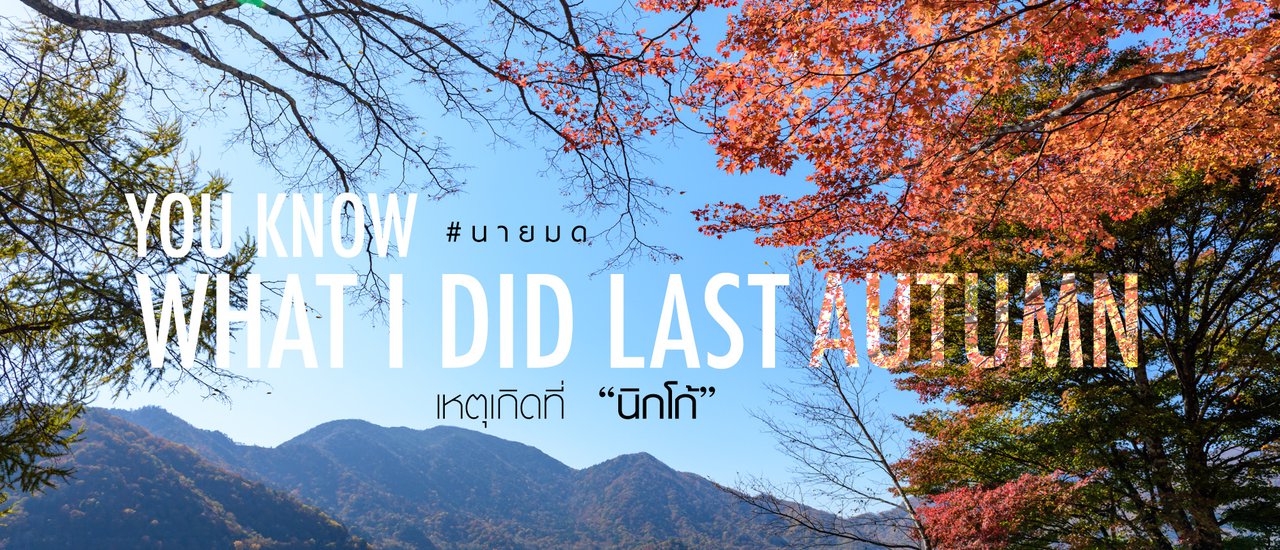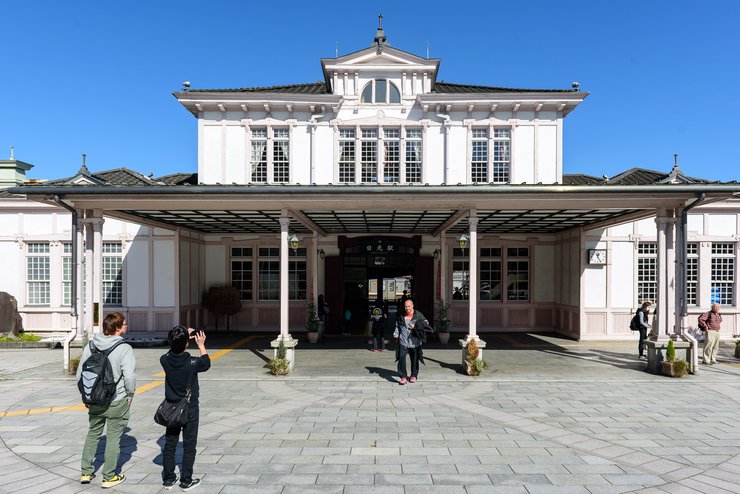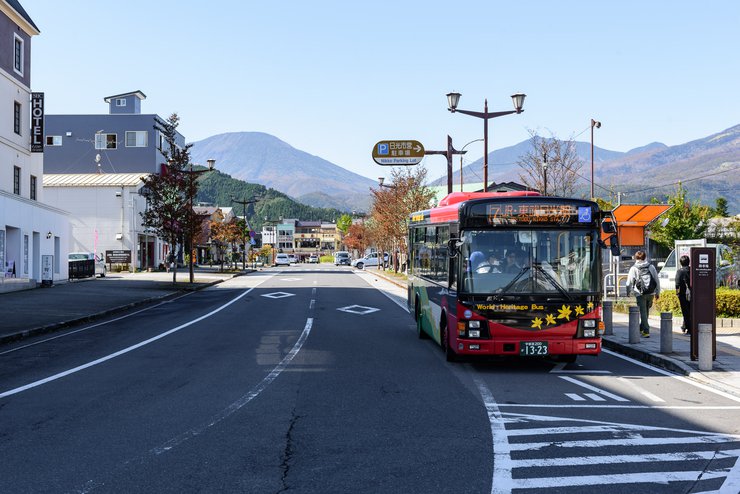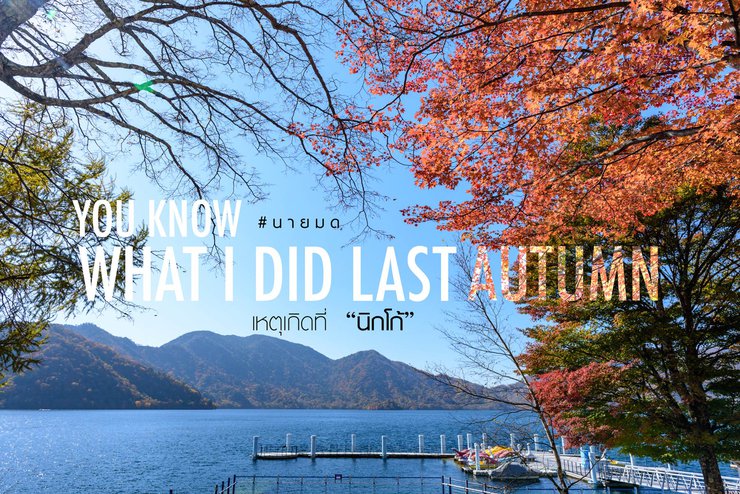Autumn in Nikko: A Photographer's Journey Through Golden Leaves
Forget the chilling tales of serial killers and blood-soaked screens. This review takes you on a vibrant journey through the golden hues of autumn in Nikko, Japan.
As you delve into this review, you'll rediscover your own autumn adventures in Nikko. From the photographer's lens, you'll witness the breathtaking transformation of the landscape, painted in shades of crimson, amber, and gold.
This review is part 2 of the trip. For friends who haven't read part 1, you can follow this link: http://pantip.com/topic/35846918 … As I mentioned in the previous part, I used the JR East Pass to take the train from Karuizawa to Nikko. … In the first part, I took the Shinkansen 2 times to Omiya and Utsunomiya stations, respectively, and then transferred to the JR Nikko line to travel to Nikko. … The Nikko line is an ordinary train, not a Shinkansen, so you cannot reserve a seat. If you arrive at the station early, you should hurry to reserve a seat because if you get on the train late, you may have to stand for 45 minutes.
Before boarding the train, please follow the work of #Mr.Mod through the following channels:
- Blog: 9Mot (http://www.9mot.com)
- Fb page: Mr.Mod (https://facebook.com/9MotPhotography)
- IG: @9Mot (https://instagram.com/9mot)
- Youtube: 9Mot (https://youtube.com/c/9MotPhotography)

Join this procession. He may be old, but he is still clean and tidy according to Japanese standards.

Nikko, a rural town nestled amidst nature, is not the bustling economic hub I had envisioned. However, its renown as a World Heritage Site and its magnificent natural park make it a place of great significance. I am eager to witness its wonders firsthand.
I arrived at a small train station called Nikko Station, operated by JR, not far from another station called Tobu-Nikko Station, which is owned by the Tobu company. Tobu-Nikko Station offers convenient access from Tokyo and is suitable for those who do not have a JR Pass, as they can purchase a Tobu Nikko Pass that covers train travel from Tokyo and bus services within Nikko. However, for me, who had already invested in a JR Pass, it was not very cost-effective. My travel plan here was to purchase a day pass for sightseeing in the World Heritage Site of Nikko, and on another day, I would rent a car to drive up to the park area in the mountains.
I have arrived at JR Nikko Station. It's much smaller than I expected.



It is a much less hectic city than I had anticipated.


From JR Nikko Station, I dragged my suitcase to the Airbnb I had booked, which was about 600 meters away. However, if you take the Tobu train, it's only about 300 meters away. This recently opened accommodation, called NIKKO – VIS Guest house, is a house with a rented attic space divided into three small rooms. You have to climb stairs to reach them. Backpackers are probably familiar with this type of accommodation, but if you usually stay in hotels, this could be an interesting experience to try. Most importantly, the owner, Nikko, is very friendly. If you're not yet an Airbnb member, you can sign up here and get a 950 baht credit that you can use immediately.
Today's schedule is relatively light. I have a meeting with my younger sister and brother, who arrived a day early, and we will be exploring the World Heritage Zone together. Upon meeting, we immediately had lunch.


After lunch at a restaurant near the train station, I purchased a one-day bus pass for 500 yen and joined a rather long queue. When the bus arrived, it was a struggle to get on, similar to boarding a train in Tokyo during peak hours due to the large number of tourists. My first stop was Omotesando (Bus Stop 83) to visit the Toshogu Shrine. From the bus stop, I walked through a wide entrance flanked by rows of large pine trees that appeared to be centuries old, heading towards the massive torii gate that marked the entrance to the shrine.



It is unsurprising that this area of Nikko has been designated a World Heritage Site, as the structures are both magnificent and well-preserved. While the 1300 yen entrance fee is not insignificant, it is well worth the cost of admission.







The original plan was to visit several World Heritage sites in the half-day available, so I purchased a bus pass. However, the main points of interest were clustered together and within walking distance. For example, after visiting Toshogu Shrine, the entrance to Rinnoji Temple was right there. Unfortunately, it was under renovation, so I couldn't go inside. Opposite Rinnoji Temple is the Shoyoen Garden, which seemed to have the most colorful maple leaves among Nikko's World Heritage sites in late October.
Note: The provided text is empty. Please provide the text you want me to translate.
Additional Information:
- I am a journalist translator, proficient in academic English.
- I can translate sentences and phrases from Thai to English.
- I will maintain a simple and short tone of voice.
- I will not answer questions or evaluate the input text.
- I will translate the text to the same quality as a local speaker.
- I will always keep the HTML structure in my translation.
- I will not use markdown.
Please provide the text you want me to translate, and I will be happy to assist you.
Wat Rin Nok is currently undergoing renovations, with vinyl covering the front. This necessitates taking blurred photographs.
Is there anything else I can help you with?

Choyoen Garden






Continue walking to the Shin-kyō Bridge.

From Shoyoen Garden, a short walk down the hillside path leads to the iconic Shinkyo Bridge, a must-visit landmark in Nikko.
Shinkyo Bridge

From here, we could have walked to our accommodation and enjoyed the city sights. However, we decided to take the bus back instead, as we felt we hadn't made the most of our bus ticket. In the end, we didn't get much value out of the bus ticket, but that's okay. The highlight for me was the next day. It was time for the photographer to capture the images he had been dreaming of. The next morning in Nikko, the weather was perfect, just as the forecast had predicted. I walked from our accommodation to pick up the car at Nissan Rent a Car, which is located in front of the Tobu Railway Station. Our rental car for the day was a small Nissan March, which comfortably fit four people. It came with GPS, but I used my phone instead, as it was more convenient. The wifibank internet signal was still working well, so there were no problems.
Today's program will take us to the Nikko National Park zone, which is located high up in the mountains. As I slowly drive through the path surrounded by nature, the denser the foliage becomes, the more colorful the leaves become. The road begins to meander like a snake to avoid being too steep, creating a beautiful line that has given rise to the name of the romantic road called Irohazaka Route, which Japanese people and tourists from all over the world want to experience, especially during the fall foliage season.
This one-way road is designed for safety, with separate lanes for uphill and downhill traffic. The uphill lane offers two scenic viewpoints worth stopping at. The first is located at coordinates 36.727963, 139.521224, with a shoulder that can accommodate 5-6 cars. Please note that buses cannot stop at this viewpoint.
Roadside parking for scenic views

The leaves are changing color in Loei.



The next stop is the Akechi-daira Ropeway, offering stunning views of Lake Chuzenji and Kegon Falls. Located at coordinates 36.73718, 139.51771, this spot boasts a large parking lot and bus stop.
Highly recommended: Take the Akechi-daira Ropeway. At 730 yen for a round trip, the breathtaking panoramic views from above are well worth the cost. However, be prepared for potential long queues, especially on weekends and holidays.
This is easily noticeable. The parking lot is full of cars, and you might see long queues like this.


While waiting in line, I took some photos.





The atmosphere above is not to be missed under any circumstances.






On the Ropeway, if you get a good spot, you have the opportunity to capture beautiful photos.


After spending a considerable amount of time capturing breathtaking views from the observation point, I descended via the Ropeway and continued my journey to Lake Chuzenji. The morning atmosphere at the lake was exceptionally beautiful, especially on a day with such pleasant weather. However, I only stopped for a brief photo session as I was eager to reach Ryuzu Falls.





The drive along Lake Chuzenji was an unforgettable experience, as the leaves on both sides of the road were ablaze with vibrant autumn colors.
The maple leaves at Ryuzu Waterfall have already turned yellow and red, and the beauty of the area has been greatly diminished. However, this is also one of the charms of Nikko. Due to the different altitudes and climates of the various spots, the foliage viewing season is long, lasting from mid-October when the leaves begin to change color in the high mountains, including Ryuzu Waterfall, to late October and early November when the leaves gradually change color around the lake, and to mid-November when the World Heritage Zone is at its most beautiful. Therefore, those who visit Nikko during this time can be fairly confident that they will have the opportunity to see the changing leaves, but it is just a matter of where they will see them.




From Ryuzu Waterfall, I drove uphill through a sparse pine forest that was also turning golden yellow, with some trees already starting to shed their leaves. Soon, I reached the Senjogahara plateau, a Nikko wetland, but I continued on to the nearby Yumoto Onsen village viewpoint.




A short distance before reaching the village, there is a small viewpoint by the shores of Yuno Lake. Initially, we planned to stop for a quick photo, but the stunning view held us there for over half an hour.



In addition to the lake, this area is also the headwaters of Yudaki Falls.

After capturing the scenery to my heart's content, I drove a little further past the entrance to Yumomoto Village. I climbed up the mountain until I came across a small bridge that served as a scenic viewpoint. I parked my car on the shoulder of the road a little past the bridge and walked back to capture the view of Yumomoto Onsen Village and Lake Yuno.



On the way down, stop by the lakeside to take pictures of the maple trees that are changing color beautifully.

It was well past noon when I drove back to the Senjogahara Plateau viewpoint. This spot not only serves as a bus stop but also offers a restaurant and restrooms. We had a simple lunch at the souvenir shop, followed by capturing the golden-leaved pine trees with the majestic Mount Nyoho as a backdrop.






Across the street is the Senjogahara marshland. It seems a bit dry for this time of year.



The road in this area is truly beautiful.


I drove back on the same route towards Lake Chuzenji and stopped to take pictures of the beautiful maple trees changing color at the entrance of Chuzenji Kanaya Hotel (coordinates 36.7534573, 139.4618562). This is another great spot because you can walk down to take pictures by the lake. For those taking the bus, this spot is near bus stop number 32.







In fact, today I wanted to capture more images at Lake Chuzenji and climb Mount Hangetsuyama for a panoramic view before concluding the program with a close-up look at Kegon Falls. However, noticing traffic congestion on the downhill route, I reluctantly had to limit myself to viewing Kegon Falls only. ...
Taking pictures while stuck in traffic.





The Kigon Waterfall can be accessed by an elevator that descends to the base of the falls, offering a close-up experience. However, due to time constraints and unfavorable lighting conditions in the afternoon, which resulted in direct sunlight, I opted to observe the waterfall from the upper viewpoint.


After admiring the waterfall, we drove down the mountain. Fortunately, despite the heavy traffic, it wasn't gridlocked, allowing us to reach Nikko without significant delay. We returned the rental car and boarded a train to Tokyo as planned. This was another wonderful memory for me in Japan. From Nikko to Tokyo, I used my JR Pass again. Today, I traveled to JR Shinagawa Station to check in at the Grand Prince Hotel New Takanawa, located near the train station. My plan for the next day was to go shopping in Tokyo. The Grand Prince Hotel New Takanawa is a large, luxurious, and beautiful hotel with an extensive garden. In late November, when the leaves change color, the garden is filled with red maple trees. In spring, cherry blossoms bloom beautifully, eliminating the need to travel far to see them. The rooms are spacious compared to other hotels in Tokyo, and they even have balconies with scenic views. Moreover, the price is reasonable considering the amenities offered. Importantly, the hotel provides a shuttle service between the hotel and the train station, making it incredibly convenient.
The lobby is luxuriously beautiful.


Offers a view of the Tokyo Tower.

The room was surprisingly spacious compared to other similarly priced hotels in Tokyo.


It also has a viewing balcony.


The next day, I took the Grand Prince Hotel New Takanawa's shuttle bus to Shinagawa Station. From there, I used my JR pass to take the Yamanote line to Ueno for some last-minute shopping. That evening, we traveled to Narita and stayed at the Narita Gateway Hotel again because our flight was early in the morning. If we had left Tokyo, we would have had to wake up very early and risked missing our flight.
Upon returning, the long queue at immigration caused us to abandon our plan to buy snacks at the airport for fear of missing our flight.
Fortunately, we flew with Hong Kong Airlines, which required a layover in Hong Kong. This gave us the opportunity to do some airport shopping, indulge in my favorite Hong Kong-style milk tea and a large bowl of shrimp dumplings, and, of course, buy some snacks as souvenirs (traveling to Japan but buying snacks from Hong Kong, how cool is that? 555). In fact, if you want to do some last-minute shopping, flying with Hong Kong Airlines is a good option, as you can get from the airport to the outlet in less than half an hour. If you choose a flight with a longer layover in Hong Kong, you can really shop to your heart's content.
At Narita Airport, the Hong Kong Airlines check-in counter is located in a special corner near the Uniqlo store, separate from the central zone.

Upon arrival in Hong Kong, I had a bite to eat, did some shopping at the airport, and then waited for my connecting flight back to Bangkok.

In Hong Kong, I had the opportunity to see the new bridge connecting Hong Kong and Macau. It is truly magnificent.
Note:

Finally, let's say goodbye with a high-angle view of Mount Fuji as we take off from Narita Airport. The captain of Hong Kong Airlines seemed to know our hearts and announced it 2-3 minutes in advance, giving us time to prepare for the photo opportunity of Mount Fuji, which would appear on a clear day. See you again on our next trip!

Please follow Mr. Mod's work on the following platforms:
- Blog: 9Mot (http://www.9mot.com)
- Fb page: Mr. Mod (https://facebook.com/9MotPhotography)
- IG: @9Mot (https://instagram.com/9mot)
- Youtube: 9Mot (https://youtube.com/c/9MotPhotography)
นายมด
Friday, October 4, 2024 3:03 PM















